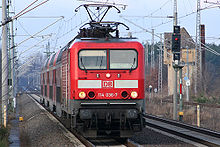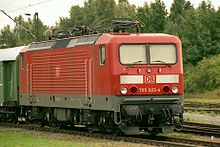- DR Class 243
-
Deutsche Reichsbahn Class 243
Deutsche Bahn Class 143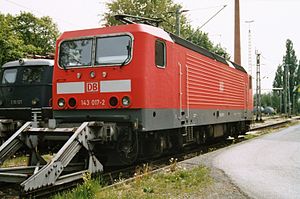
Locomotive 143 017-2 in Nürnberg Power type Electric Builder LEW Hennigsdorf Total produced 636 UIC classification Bo'Bo' Gauge 1,435 mm (4 ft 8 1⁄2 in) Length 16.64 m (54 ft 7 in) Locomotive weight 82.5 tonnes (81.2 long tons; 90.9 short tons) Traction motors Four Top speed 120 km/h (75 mph) Power output 3,720 kW (4,990 hp) Tractive effort 240 kN (54,000 lbf) Locomotive brakes KE-GPR-E + ep // Knorr air brakes and electric resistance brake Safety systems Sifa / PZB / LZB Class DR: 243
DB: 143First run 1985 Last run Still in active service - first 11 withdrawn in 2008 The DR Class 243 is a universal electric locomotive of the Deutsche Reichsbahn which is used for general rail service. Deutsche Bahn lists the locomotive as Class 143. The locomotives of class 143/243 still belong to the most successful class of German electric locomotives.
Contents
Development
 143 184-0 near Unkel
143 184-0 near Unkel
Since 1980 the Deutsche Reichsbahn of the GDR started increasing track electrification due to rising oil prices. Before that the DR had mainly used locomotives driven by Russian diesel fuel. VEB Lokomotivbau und Elektrotechnische Werke Hennigsdorf, the only manufacturer of electric locomotives in the GDR, received the order to develop, a lighter, four-axle and technically modern electric locomotive for passenger transport and medium cargo service based on the heavy cargo locomotive DR Class 250. The mechanical components were developed and produced in Hennigsdorf. The electric motors were manufactured by EMW Dresden.
The prototype locomotive 212 001 was built in 1982 and presented to the public in the same year with a designed maximum speed of 140 kilometres per hour (87 mph). It did several testing before it was modified in order to operate at a maximum speed of 120 km/h (75 mph) with also changing the number to 243 001. Because of its special painting (white with red stripes), 243 001 was given the nickname Weiße Lady (White Lady). The production of the series was started in 1985 after the testing with 243 001 was successful.
Series Production
DR Class 243
In 1985 there were no parts of the DR network on which speeds over 120 kilometres per hour (75 mph) were permitted, so large numbers of Class 243 locomotives were acquired. In 1984 the first 20 were delivered, followed by 80 in 1985, 100 in 1986, 110 in 1987 and 114 in 1988. At the end of 1989 the 500th locomotive was completed.[1]
Locomotives manufactured from 1987 (from 143 302) were equipped with a more streamlined front, which reduced energy consumption by about 5% by reducing air resistance.
From 1988 the Class 243.8 locomotives received multiple-unit train control equipment.[1] Subsequently 109 locomotives without multiple unit train control were acquired up to December 1990, so that the DR had in total 636 Class 243 locomotives at their disposal. 243 659 was the final Class 243 locomotive enter service on 2 January 1991.
After German reunification goods traffic in the former East Germany came to a standstill and many Class 243 locomotives stood on sidings with no work. From August 1990 locomotive 243 922 (later DB 143 922) was hired to the Südostbahn (Swiss South-Eastern Railway). Others went to Freiburg und Düsseldorf for testing by Deutsche Bundesbahn.
DBAG Class 143
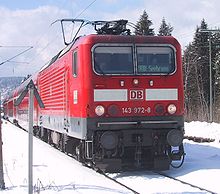 143 972 on the Höllentalbahn
143 972 on the Höllentalbahn
The following year more locomotives were moved to the west where they were used on the Schwarzwaldbahn, the Höllentalbahn, the Rhein-Ruhr S-Bahn and goods trains from Dortmund. After the DB and DR were combined in 1994 to form Deutschen Bahn AG the Class 143 locomotives were used on many more lines in the former West Germany.
The former 212 001 remained the property of LEW and after testing by the DR from 1982 to 1984 was used for various measuring and experimental tasks. In 2002 it was sold to EKO-Trans and (now numbered 143 001) was painted in their red and silver livery. In May 2008 143 001 was repainted orange with the logo of its new owner, Arcelor Mittal.[2]
Six Class 143 locomotives (041, 069, 186, 191, 286, 874) have been sold to Bahn- und Hafenbetriebe der Ruhrkohle AG[3] and a further six (179, 204, 257, 344, 851, 864) to Mitteldeutsche Eisenbahn Gesellschaft (MEG) where they have been renumbered as MEG 601-606.[4]
DBAG Class 114.1 and 114.3
Many Class 143 locomotives were in use for passenger traffic and on longer Regionalbahn and Regional-Express services, so the maximum speed of 120 km/h was awkward, especially as the carriages often had a maximum speed of 140 or 160 km/h. It was planned to rebuild some locomotives with higher maximum speeds of 140 and 160 km/h, which would be classified as Class 114.3 and Class 114.1 respectively.
143 171 was rebuilt with a maximum speed of 160 km/h and renumbered as 114 101. During the rebuilding the pantograph was replaced with a newer model of type SSS 87 and the train protection system and brake equipment were adapted for higher speeds. The gear ratio between the motors and wheels was also changed and dampers were fitted between the locomotive body and the bogies.
143 120 was rebuilt into 114 301 with a maximum speed of 140 km/h. This did not require changes to the gear ratio or the fitting of dampers.
Both rebuilt locomotives were tested in test service and normal use around Magdeburg. The upgrading to 160 km/h cost € 300,000 per locomotive and upgrading to 140 km/h cost € 48,000 per locomotive. For this reason only speed increases to 140 km/h have followed.
DR Class 212 to DBAG Class 112
DR Class 212 and 112.0
DB and DR Class 112.1
DBAG Class 112.1 and 112.0
DBAG Class 112 and 114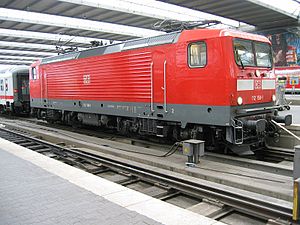
112 158-1 in Munich Power type Electric Builder LEW Hennigsdorf (since 1992 AEG) Total produced 130 UIC classification Bo'Bo' Gauge 1,435 mm (4 ft 8 1⁄2 in) Length 16.64 m (54 ft 7 in) Locomotive weight 82.5 tonnes (81.2 long tons; 90.9 short tons) Traction motors Four Top speed 160 km/h (99 mph) Power output 4,220 kW (5,660 hp) Tractive effort 248 kN (56,000 lbf) Safety systems PZ 80 (112.0) LZB I 80 (112.1) Following German reunification, the rail routes to Berlin were rebuilt with a maximum speed of more than 120 km/h. The Deutsche Reichsbahn had no locomotives capable of this speed so it had to acquire new faster locomotives. However, the Class 212 locomotives had originally been designed with a maximum speed of 160 km/h. After four prototype locomotives (numbered 212 002 to 212 005, the number 212 001 had originally been used for 143 001 and was not reused) a series of 35 locomotives (212 006 to 212 040) was delivered.
The Class 112 locomotives became an unexpected symbol of German reunification because they were the first locomotive class to be used by both the Deutsche Reichsbahn and the Deutsche Bundesbahn. DR and DB each ordered 45 slightly improved locomotives of Class 112.1 from AEG, who had taken over LEW Hennigsdorf as they had owned the factory in 1946. The decision for DB to order Class 112.1 locomotives was mainly to support the factory at Hennigsdorf as DB would have preferred a 200 km/h universal locomotive such as the Class 120.
After overcoming a few initial problems the Class 112 were mainly used on InterRegio trains. In 1995, 112 025 (the former 212 025) was renumbered as test locomotive 755 025. Following the end of InterRegio services and the upgrading of Regional-Express rolling stock for speeds of 140 km/h and 160 km/h the Class 112 locomotives are used predominantly for regional services. On 1 January 2004 DB Fernverkehr transferred all its Class 112.1 locomotives to DB Regio.
DBAG Class 114
All 38 locomotives of Class 112.0 were reclassified as Class 114 on 1 April 2000 because up to this time these locomotives had been used exclusively for regional trains in Berlin, Brandenburg and Mecklenburg-Vorpommern and there were several differences between these locomotives and the Class 112.1. Following the transfer of the remaining Class 112 locomotives to DB Regio the reason for the different classifications is unnecessary as there are similar differences between locomotives within Class 143.
DBAG 755 025
The VES-M Halle (Research Institute Halle) needed a fast electric locomotive for their measuring and test trains. In January 1995 they received 112 025 which was renumbered 755 025. Today it is numbered 114 501.
Sources
- Michael Dostal: Baureihen 112, 143: Moderne Elektrolokomotiven für ganz Deutschland. GeraMond, München 2000 ISBN 3-932785-50-9
- Gottfried Köhler: Neuentwickelte Ellok BR 212/243 für die DR. In: Modelleisenbahner. Nr. 7/Jahrgang 31/1982. transpress VEB Verlag für Verkehrswesen Berlin, ISSN 0026-7422, S. 4-6.
- Wolfgang Faust: Die neue Ellok in der Betriebserprobung. In: Modelleisenbahner. Nr. 10/Jahrgang 33/1984. transpress VEB Verlag für Verkehrswesen Berlin, ISSN 0026-7422, S. 4.
- Michael Gröbner: Baureihe 143. Im Führerstand. In: LOK MAGAZIN. Nr. 250/Jahrgang 41/2002. GeraNova Zeitschriftenverlag GmbH München, ISSN 0458-1822, S. 48-51.
References
- ^ a b Report 500. Serienlok seit 1984 für Deutsche Reichsbahn. In: Die Bundesbahn. Nr. 12, 1989, Page 1116
- ^ "http://br143.lok-datenbank.de/ - 143 001 (German)". http://br143.lok-datenbank.de/index.php?nav=1000001&lang=1&id=24037&action=portrait. Retrieved 2008-10-01.
- ^ "Railfaneurope.net - RAG Stock List". http://www.railfaneurope.net/list/germany/germany_rag.html. Retrieved 2008-10-01.
- ^ "Railfaneurope.net - MEG Stock List". http://www.railfaneurope.net/list/germany/germany_meg-b.html. Retrieved 2008-10-01.
External links
Classes of German electric locomotives Current class numbering 101 · 103 · 104 · 109 · 110 · 111 · 112 · 112 (old) · 113 · 114 · 114 (old) · 115 · 116 · 117 · 118 · 119 · 120 · 127 · 128 · 132 · 139 · 140 · 141 · 142 · 143 · 144 · 145 · 146 · 146.1 · 146.2 · 150 · 151 · 152 · 152 (DB) · 155 · 156 · 160 · 163 · 169 · 171 · 175 · 180 · 181 · 182 · 182 alt · 183 · 183 alt · 184 · 185 · 186 · 188 · 189 · 190 · 191 · 193 · 193 (old) · 194
Pre-1968 class numbering DR classes Older DR classes see also Category:Deutsche Bundesbahn locomotives , Category:Deutsche Reichsbahn (East Germany) locomotives , Category:Deutsche Bahn locomotivesCategories:- Electric locomotives of Germany
- 15 kV AC locomotives
- Deutsche Reichsbahn (East Germany) locomotives
- Bo-Bo locomotives
- Railway locomotives introduced in 1982
Wikimedia Foundation. 2010.

